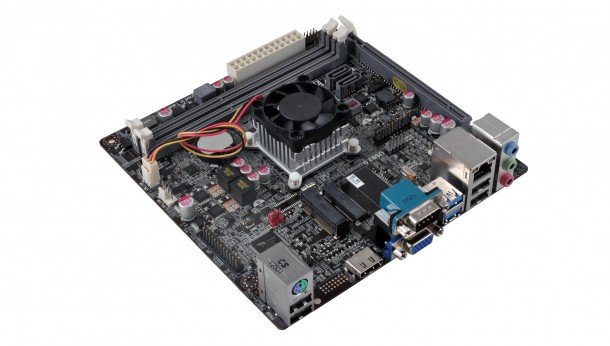Mini-motherboards: the shape of things to come?

So motherboard makers ECS have just announced their new mini-ITX motherboard introducing the AMD Kabini platform to the desktop masses. It's got a soldered-on SoC (system-on-a-chip) AMD A6-5200, housing four 28nm Jaguar cores and the Radeon HD 8400 Graphics Core Next GPU.
With a whole suite of expansion opportunities in this tiny mobo footprint too is this motherboard the shape of our future PCs? Of course not, after all who would be crazy enough to build a mid-level gaming PC using just AMD Jaguar cores ? Oh, hold on a second.
But this has still gotten me thinking about the future of the desktop PC and whether we really need to have those chunky ATX mobos anymore.
This AMD Kabini-based motherboard/APU combo isn't a particularly powerful setup, indeed the APU at its heart has, at best, half the computational power of the upcoming SoC processors in the Playstation 4 and Xbox One. But even this low-end motherboard has expansions slots which could happily house an SSD and PCIe graphics card which could in turn offer some decent low-end gaming performance.
Look higher up the stack, at the likes of Intel's Z87 micro ATX or mini-ITX motherboards, though and you can jam in top-end CPUs and pair them with proper discrete graphics cards to rival pretty much any ATX-scale desktop machine on the market.
It used to be the smaller form factor boards were sacrificing performance to be able to squeeze down to this micro scale. Now that so much of the performance-critical hardware is based within the processor package, rather than in motherboard silicon, the boards themselves don't need so much hardware on them to make up a competitive gaming system.

The other thing about this board which potentially offers a glimpse into the PC gaming future is that soldered-on processor. This is already on the cards with Intel's Iris Pro Haswell CPU only set to make an appearance on the desktop in a BGA (Ball Grid Array) setup. That means it's soldered onto the board much like the Kabini APU on the ECS mobo above.
Keep up to date with the most important stories and the best deals, as picked by the PC Gamer team.
And, if reports are true, the 14nm Broadwell chips on the far horizon are likely to see a number of BGA offerings too.
Personally I think the ATX form factor's days are numbered. You can already fit enough hardware onto a mini mobo to allow for some pretty hefty overclocking and if you're adamant you want to sell your soul to the many-tentacled god of multi-GPU gaming then mATX boards, like Gigabyte's G1.Sniper M5 , will cater to your dual-card fancies.
But what do you guys think? What would make you stick with a standard ATX board for your next build or are you tempted by a micro machine?

Dave has been gaming since the days of Zaxxon and Lady Bug on the Colecovision, and code books for the Commodore Vic 20 (Death Race 2000!). He built his first gaming PC at the tender age of 16, and finally finished bug-fixing the Cyrix-based system around a year later. When he dropped it out of the window. He first started writing for Official PlayStation Magazine and Xbox World many decades ago, then moved onto PC Format full-time, then PC Gamer, TechRadar, and T3 among others. Now he's back, writing about the nightmarish graphics card market, CPUs with more cores than sense, gaming laptops hotter than the sun, and SSDs more capacious than a Cybertruck.

